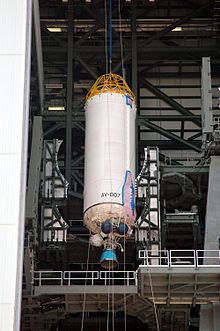Centaur (rocket upper stage)
Centaur is the name of a rocket stage powered by liquid hydrogen and liquid oxygen (LH2 / LOX) , which was often used with the Atlas rocket (Atlas Centaur) and the Titan rocket (Titan-Centaur) . A planned operation with the space shuttle was no longer carried out after the Challenger disaster for safety reasons (due to the highly explosive fuel of the Centaur).
The Centaur has been developed since 1959 by a team led by Krafft Ehricke and is the world's first rocket stage to use liquid hydrogen and liquid oxygen as fuel. It has been in use since 1963. The Centaur stage has its own control system and can be ignited several times. It is supported by the RL10 -Triebwerk of Pratt & Whitney powered. Originally the Centaur stage was always powered by two RL-10 engines, but the Atlas III and Atlas V missiles mainly use versions with only one engine (Single Engine Centaur, SEC), which increases the performance geostationary transfer orbits optimized. For heavy payloads in low orbits, the version with two engines (Dual Engine Centaur, DEC) is still used. Centaur is currently used as the upper stage of the Atlas V rocket.
Web links
- The Centaur Upper School by Bernd Leitenberger (German)
- Centaur dates and start list of Gunter Krebs (English)
- The book: "Taming Liquid Hydrogen: The Centaur Upper Stage Rocket, 1958-2002", (NASA SP-2004-4230) at NASA History Online (English; PDF; 2.3 MB)
